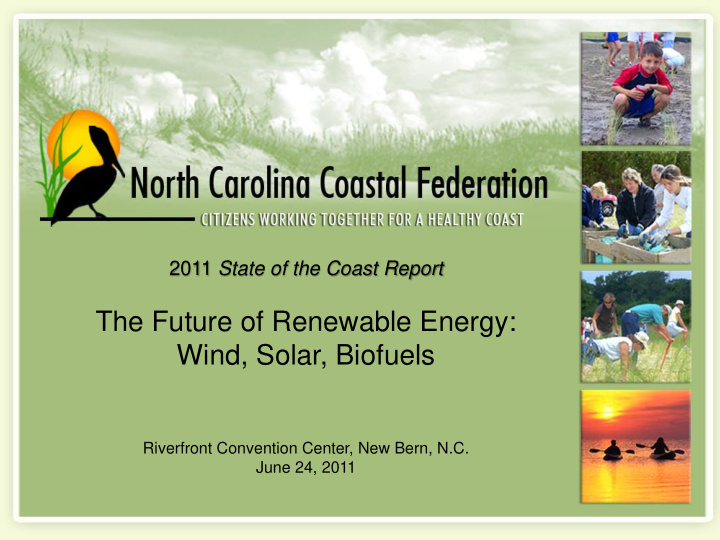



2011 State of the Coast Report The Future of Renewable Energy: Wind, Solar, Biofuels Riverfront Convention Center, New Bern, N.C. June 24, 2011
North Carolina Coastal Federation • Founded in 1982 • Non-profit 501(c)(3) • 10,000 Members • 1,200 student/adult volunteers • Staff of 19 • 27 board members • 3 regional offices Education • Restoration & Preservation • Advocacy
State of the Coast Report • Annual publication • Explores major coastal issues • Distributed statewide
Why Energy? • Important generational issue • The N.C. Coastal Federation is opposed to offshore drilling • Recognize the need to develop national energy sources • Can’t always say “no” • Is there a better way?
State of the Coast Report Summary What are the possible, realistic alternatives for renewable energy and how might they affect the N.C. coast? What are the tradeoffs? Definition: Renewable energy is energy that comes from natural sources – sunlight, wind – and naturally replenished. Report focused on: • Wind (offshore, land-based) • Solar • Bioenergy
Offshore Wind • Proven success in Europe. None in the United States. • North Carolina has the best potential of any East Coast state. Benefits • No emissions • Job creation • Minimal environmental effects • Decreased visual impacts • Create marine habitats Challenges • Fickle • Relatively expensive • Siting to avoid conflicts
Onshore Wind U.S. leads the world in electricity produced by land-based wind farms. Benefits Challenges • • No emissions Even more fickle than offshore wind • • Job creation Bird/bat strikes • • Competitive pricing Visual impacts • • Lease payments to landowners Requires large tracts
Solar Expanding rapidly in U.S. Could provide 10% of electricity by 2025. Benefits • Maybe the cleanest of fuels • Highly adaptable • Low maintenance • Tax credits available Challenges • Sun doesn’t always shine • Equipment expense • Large area needed for utility-scale production
Bioenergy Renewable energy sources comprised of biological material, including wood, crops and animal and municipal solid waste. Push is on. Benefits • Homegrown • Job creation • Income for farmer, landowner Challenges • Carbon reduction • Sustainable forestry, farming practices • Public acceptance
Conservation Conserving energy is usually the smartest, most economical and most potent environmental action you can take. 21 Things We All Can Do • Get an energy audit • Turn off the lights, TV, computer • Compact fluorescent bulbs • Efficient appliances • Weatherize • Plant native trees • Become an advocate
Recommend
More recommend